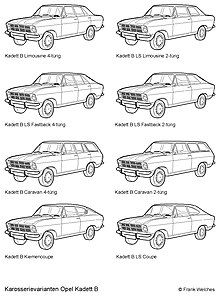Body shape

The body shape , also body type or vehicle and body type , describes the structural design of a vehicle body . A body shape can be used in different sizes and vehicle classes. Some names still come from the time of the carriages or horse-drawn wagons. The original characteristics of a particular carriage shape did not always last over the years. The coupé carriage shape has very little to do with the coupé forms in modern automobile construction.
Relevant standards for the definition of body designs are z. B. the German national standard DIN 70011 and the international standard ISO 3833. However, these differ in part from the generally used terms, which are also subject to changes in use over time (e.g. due to marketing by automobile manufacturers).
The directory for the systematisation of motor vehicles and their trailers was published in Germany and came into force on October 1, 2005 for the uniform recording of the data to be stored in the vehicle registers and for the uniform statistical evidence of the vehicle data recorded in the Central Vehicle Register (ZFZR).
Body designs can be distinguished as follows, for example:
Open designs
-
Cabriolet
- Roadster (two-seater, with up to two doors)
- Runabout
- Kübelwagen (originally no doors)
- Touring car (also: touring )
- Torpedo (also: tourer )
- Baquet
- Phaeton
- Landaulet
Examples
Closed designs
- Sedan (with saloon or hatchback , occasionally also with hatchback executed)
- Coupé (two-door, if the tailgate is not counted)
- Station wagon (increased loading volume, closure as a hatchback )
Examples
Sedan with two doors and hatchback
Sedan with four doors and notchback
Sedan with four doors and hatchback as well as large tailgate (also known as five-door)
Sedan with four doors and hatchback (also five-door)
Coupé with hatchback and large tailgate (also called station wagon coupe )
Station wagon with three doors
Five-door station wagon
Mixed and special forms
Coupé de Ville (also Sedanca or Town Car)
literature
- Hans-Hermann Braess, Ulrich Seiffert: Vieweg manual automotive technology. 2nd edition, Friedrich Vieweg & Sohn Verlagsgesellschaft mbH, Braunschweig / Wiesbaden, 2001, ISBN 3-528-13114-4
- Jan Drummans: The car and its technology. 1st edition, Motorbuchverlag, Stuttgart, 1992, ISBN 3-613-01288-X
Individual evidence
- ↑ KBA: Directory for the systematisation of motor vehicles and their trailers , 7th edition, status: June 2012, Part A 1B ( Memento from October 19, 2013 in the Internet Archive ) (PDF; 1.7 MB), accessed October 18, 2013
- ↑ KBA: Directory for the systematisation of motor vehicles and their trailers (systematic directories PDF files)


















